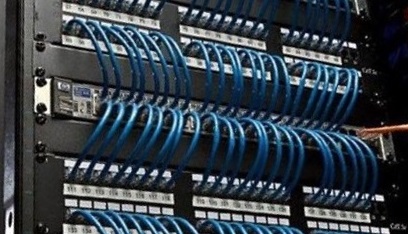
One thing computer networking books don't provide a lot of information about is the patch panel. However, the patch panel is one of the most important parts of a network because it's the point at which most of the cables come together to form a network. Of course with wireless network you don't need a patch panel, but most corporate LAN networks are wired because they provides better security.
Cables coming from your network devices and wall jacks are connected to punch down blocks on the back of the patch panel. Then these are connected to other devices using jacks and patch cables at the front of the patch panel. Much like an old telephone switchboard, to change the connection, change which jack the patch cable goes to.
Patch panels are used to organize the network cables. Each socket on the front of the patch panel is usually labeled with the identity of the device connected on its punch down connector on the back of the panel. Often, different colored patch cables are used to make it easy to identify what a patch cable is used for.
Patch panels also make it easier to troubleshooting network problem since they provide a single location connected to all network devices. By simply changing patch cables defective network device can be switched out with a known good device.
Patch panels are usually specified by the number of ports they have. 12-port, 24-port, and 48-port, 72-port, and 96-port panels are available. They are also specified by the specific cable type that they are designed for. Patch panels are designed for Cat 5, Cat 6, Cat 6 and Cat 7 cables. There are patch panels designed for fiber optic cables.
Patch panels are typically mounted in a steel frame, sometimes called a rack. Along with the patch panels, network switches, and other network monitoring and control devices can be mounted in the frame. Large organizations will have multiple frames loaded with patch panels, switches, and other devices installed in a room called a wiring closet.
Some enterprises will have hundreds, even thousands of frames. The frames are installed in a room called an equipment room. Some large enterprises will have entire floors of a building filled with frames. The frames will always be behind secure entries and the rooms will be climate controlled. Such large enterprises will also have backup power generators.
More Networking Basics:
• Network Servers
• What is a Network Sniffer Used For?
• Definition: Cloud Computing
• Best CompTIA Network+ Certification Exam Preparation Materials
• A Complete Explanation of Cloud Computing
• What is DSL and how can it benefit my home or small business?
• What is Cloud Computing?
• Degree verses Computer Certifications
• Servers - Racks, Blades and Towers
• Media Access Control (MAC) Sublayer of the OSI Data Link Layer


